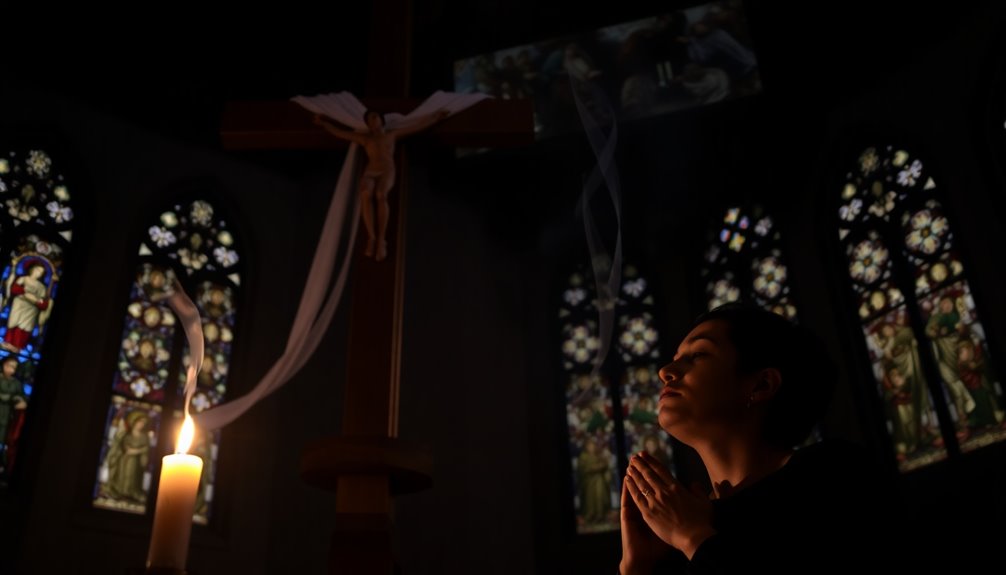Symbolism isn't a sin when it helps you grow in your faith and understand God better! It's all about how you use symbols. For example, the cross reminds us of God's love, but it shouldn't be worshipped like an idol. Instead, symbols should deepen your understanding and encourage your heart to focus on God. Remember, what matters is your intention behind using symbols. They can create joy and connection within your community too! If you're curious about how symbols can enhance your spiritual journey, there's so much more to explore!
Key Takeaways
- Symbolism itself is not a sin; it depends on the intention behind its use in worship and faith practices.
- The Second Commandment prohibits idol worship, not the use of symbols to enhance understanding of God.
- Symbols should serve as reminders of faith, not objects of worship or distraction from God.
- Personal convictions about symbols vary, and believers should be mindful of others' perceptions to avoid misunderstandings.
- Authenticity in the use of symbols is essential; they should reflect genuine faith and inspire positive witness.
Biblical Perspectives on Symbols

While some might view symbols as potentially problematic in faith, the Bible offers a nuanced perspective on their use. The Second Commandment clearly tells us not to create graven images for worship. This means we shouldn't treat symbols as objects of veneration.
However, that doesn't mean symbols are bad! In fact, they can help us understand deep spiritual truths. For example, the cross is a powerful symbol in Christianity. It represents redemption and love, but it's not something we worship.
Using symbols can be a great way to teach and clarify important ideas about God. Just remember, they should never replace our direct worship of Him. It's also important to think about how we use symbols. Wearing jewelry or crosses can be fine, but they shouldn't distract from our faith or how we treat others.
Ultimately, the intention behind using symbols matters a lot. They should help you share and understand your faith better, not take the place of worshiping God.
The Role of Symbols in Worship

Recognizing the significance of symbols in worship can deepen your understanding of faith and enhance your spiritual experience. Symbols used in worship, like the cross or fish, can remind you of God's love and teachings. However, it is crucial to remember not to worship them or serve them as idols.
Here's a simple table to help you understand the role of symbols in worship:
| Symbols | Purpose |
|---|---|
| The Cross | Represents Jesus' sacrifice |
| The Fish | Early sign of Christianity |
| Bread & Wine | Represents communion with God |
| The Bible | God's word and teachings |
These symbols can help you think about God and His messages. They should enhance your worship, not take the place of your relationship with Him. Always check your heart's intention. If you focus on the symbol instead of God, you might be tempted to make idols. Remember, your faith connects you directly to God, and symbols should point you toward Him. Enjoy using these reminders as tools to grow closer to God!
Understanding Idolatry and Symbolism

Understanding the line between symbolism and idolatry is essential for your spiritual journey. Idolatry means worshipping graven images or symbols as if they were gods, which God clearly says we shouldn't do in Exodus 20:4-6. This warning helps keep our focus on Him alone.
In the New Scriptures, like in 1 Corinthians 10:14, we're reminded again to avoid idolatry. It's important to remember that symbols can be helpful tools! They can teach us about our faith, showing us ideas like the Trinity, without becoming objects of worship.
When you see a symbol, think about its purpose. Is it helping you understand your beliefs better? If so, that's great! But if it starts to feel like it's taking the place of God in your heart, that's a red flag.
The key is balance. Using symbols for teaching and identification is perfectly fine, as long as you don't treat them like gods.
Keep your heart focused on worshipping God alone, and you'll stay on the right path. Embrace symbols as joyful reminders of your faith, not as things to worship.
Cultural Significance of Christian Symbols

Christian symbols, like the cross and the fish, are more than just pictures; they carry deep meanings that connect us to our faith.
These symbols have fascinating histories and help shape our communities by bringing people together and reminding us of our shared beliefs.
When you understand the stories behind these symbols, you can see how they impact our spiritual journeys and make worship even more special!
Historical Context of Symbols
Symbols have played a significant role in shaping the identity and practices of Christianity throughout history. When you think of Christian symbols, you might picture the cross or the fish. These symbols emerged long ago, especially during the early church, as ways for believers to identify themselves in a world filled with different beliefs.
In the catacombs of Rome, early Christians used symbols to share their faith and provide hope during tough times. For example, the dove represents the Holy Spirit, while the lamb symbolizes Christ's sacrifice. These images come from the Old scriptures, where the LORD your God is described as a jealous God who desires His people to follow Him closely, highlighted in the Ten Commandments.
Throughout the years, different Christian groups have embraced or set aside symbols based on their beliefs. This has led to a rich variety in how symbols are used in worship.
Beyond church walls, Christian symbols have influenced art, literature, and social movements, often showing the strength of faith. They remind us of the deep connections we share and the stories we tell through our beliefs.
Symbols and Community Identity
Throughout history, symbols have woven themselves into the fabric of community identity among believers. Think about the cross or the fish; these images aren't just pretty pictures. They represent your faith and help you feel connected to others in your community. When you see these symbols, it's like a warm hug from your church family.
Symbols carry cultural significance, often showing shared beliefs and values that unite congregations. They enhance collective worship experiences, making everyone feel included. Each symbol tells a story, reflecting the traditions and teachings of Christianity. This connection to history helps deepen your understanding of who you're as part of a community of believers.
In many Christian communities, symbols act as bridges, linking individuals to their spiritual journeys. They remind you that you're not alone; you're on a shared mission with others.
Plus, using symbols can spark exciting discussions about faith! They encourage you to think about your values and beliefs, and how they fit into the larger picture of your community.
Spiritual Meaning and Impact
How do symbols shape your spiritual journey? Christian symbols, like the cross and the fish, carry deep spiritual significance. They represent important parts of your faith, such as redemption and Jesus as your Savior. These symbols can also strengthen your communal identity, fostering a sense of belonging with other believers.
Here are three ways Christian symbols impact your spiritual life:
- Educational Tools: Symbols help explain complex theological concepts, making your beliefs clearer without being objects of worship.
- Community Connection: Using these symbols in worship can enhance shared experiences, bringing you closer to others in your faith community.
- Public Perception: Displaying Christian symbols can influence how others view Christianity. It shows your beliefs and might encourage conversations about faith.
In many cultures, the meanings of symbols can change over time. This can affect how you and others perceive these symbols.
Personal Convictions and Symbol Use

When steering the use of symbols in your faith journey, it's important to recognize that personal convictions can greatly differ among believers. Some folks might feel that wearing a cross is meaningful, while others may think it's wrong. Romans 14 reminds us to respect these personal convictions. If someone sees a symbol as sinful, they should refrain from using it. Remember, we shall not worship the symbol itself; it's about what the symbol represents.
The intention behind using symbols matters a lot! They should enhance your witness and not become distractions. Here's a simple table to help you think about this:
| Symbol | Personal Conviction | Intention |
|---|---|---|
| Cross | Represents faith and sacrifice | To remind others of Jesus' love |
| Fish | Symbol of Christianity | To share faith with joy |
| Dove | Peace and the Holy Spirit | To symbolize hope |
| Heart | Love and compassion | To show kindness |
Engaging in open discussions about symbols can build understanding and unity. So, let's explore these convictions together!
The Impact of Symbols on Faith

Symbols hold a profound significance in shaping your faith experience. They act as powerful reminders of your beliefs and can help strengthen your identity as a follower of Christ. Just think about how you might feel when you see someone display a fish symbol or wear a cross. These symbols can spark joy and connection among believers.
Here are three ways symbols impact your faith:
- Community Connection: When you share symbols, like the fish, you foster a sense of belonging within your church family. It unites you in shared beliefs and experiences.
- Authentic Christian Witness: Wearing a cross shouldn't just be for show; it should reflect your actions. Matthew 5:16 teaches that your good works glorify God, showing that symbols complement your faith.
- Mindful Display: Symbols should be displayed thoughtfully. Romans 14 reminds you to reflect on how others may see your symbols, avoiding any perception of iniquity of the fathers.
In the end, symbols can enhance your journey toward the kingdom of heaven. By thoughtfully using symbols, you can create a joyful and authentic Christian witness that uplifts everyone around you!
Frequently Asked Questions
What Does the Bible Say About Symbolism?
The Bible uses symbolism to help you understand important ideas about God and life. For example, a lamb represents sacrifice, showing Jesus's love for everyone.
The cross stands for redemption, reminding you of hope and forgiveness. Symbols like these make complex ideas easier to grasp.
It's key to remember that while symbols can teach, they shouldn't replace true worship. When used correctly, they deepen your connection to faith and its powerful messages!
Is Symbolism Allowed in Christianity?
Yes, symbolism is allowed in Christianity! Symbols can help you understand your faith better.
Think about the cross or the fish; these symbols remind you of important beliefs. They're not idols, so you won't worship them. Instead, you use them to connect with God and others.
Just remember to be mindful of how others feel about symbols, too. They can bring joy and help you share your faith in a special way!
What Is the Symbolism of Sin?
The symbolism of sin is really interesting! In the Bible, darkness represents sin, showing how it separates us from God.
The serpent in Genesis symbolizes temptation, reminding us to be cautious.
Leaven shows how sin can spread quickly, like yeast in bread!
A broken heart symbolizes recognizing our mistakes and needing forgiveness.
Finally, the scarlet thread highlights that even though sin stains us, redemption is always possible through Christ's love.
Isn't that amazing?
Does the Bible Say Not to Have Icons?
The Bible doesn't say you can't have icons! It actually guides us about their use.
While it warns against worshipping idols, it allows images to teach important lessons. For example, God used symbols like the bronze serpent for special reasons, reminding us that symbols can help us understand deeper truths.
Just remember, it's all about your heart! If you use icons to learn, rather than worship, you're on the right path!
Conclusion
In the end, symbols can be powerful tools in your faith journey. They help you connect with God, just like a rainbow reminds you of His promises. While it's important to avoid turning symbols into idols, using them thoughtfully can enhance your worship and understanding. So, embrace the beauty of symbolism! Let it inspire you and others, shining light on your beliefs. Remember, it's your heart that truly matters when it comes to expressing your faith.











